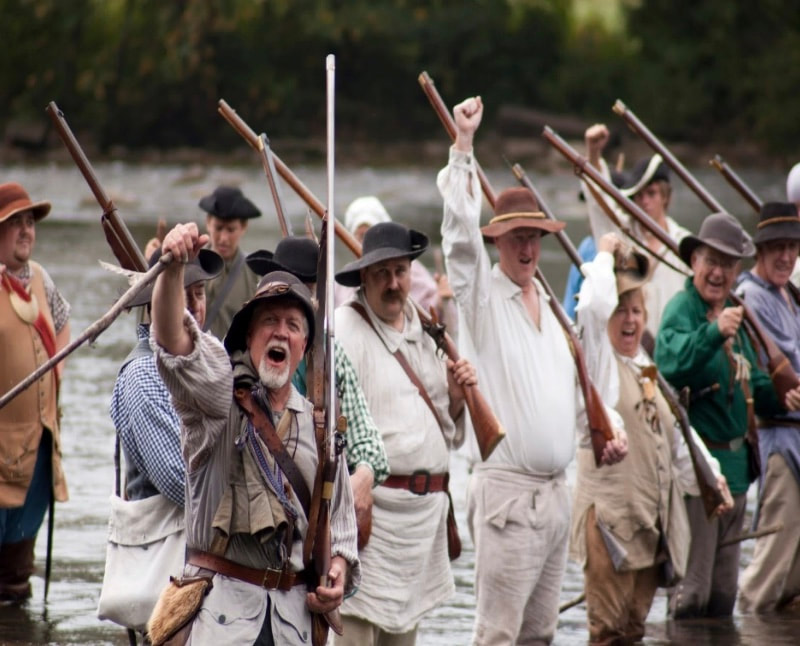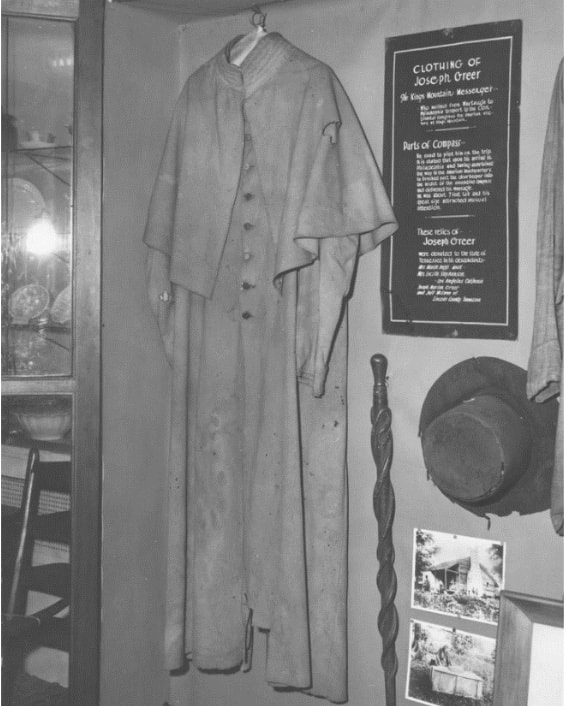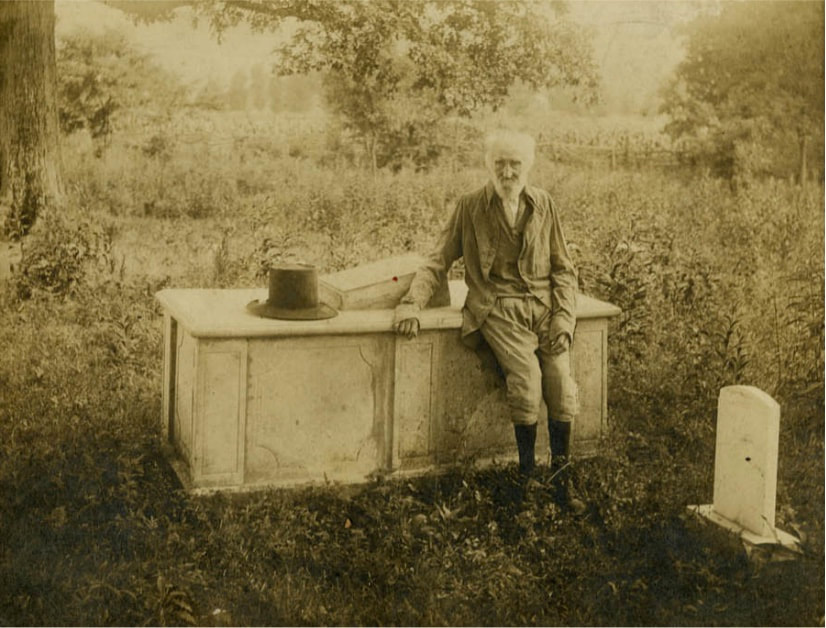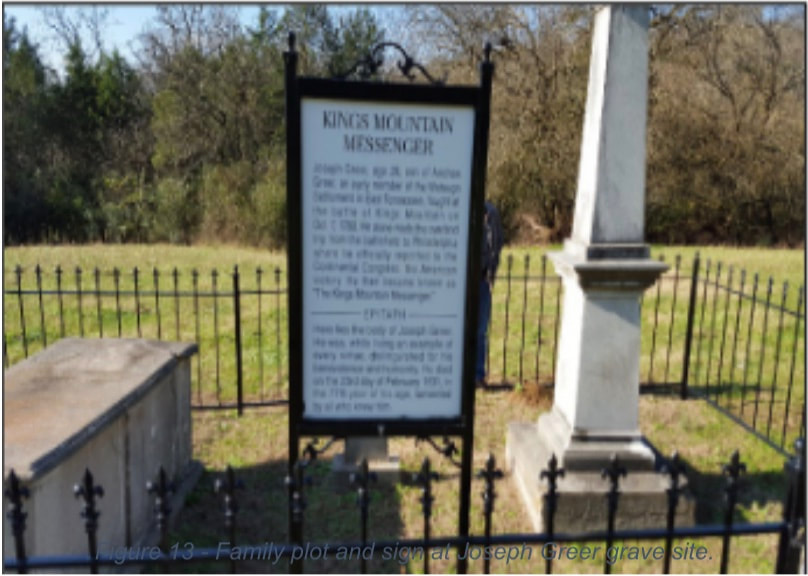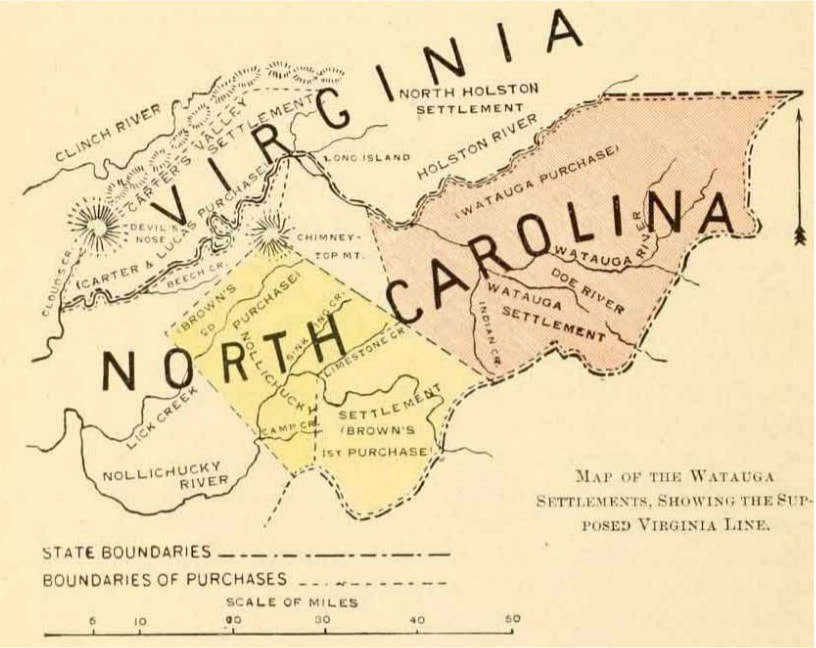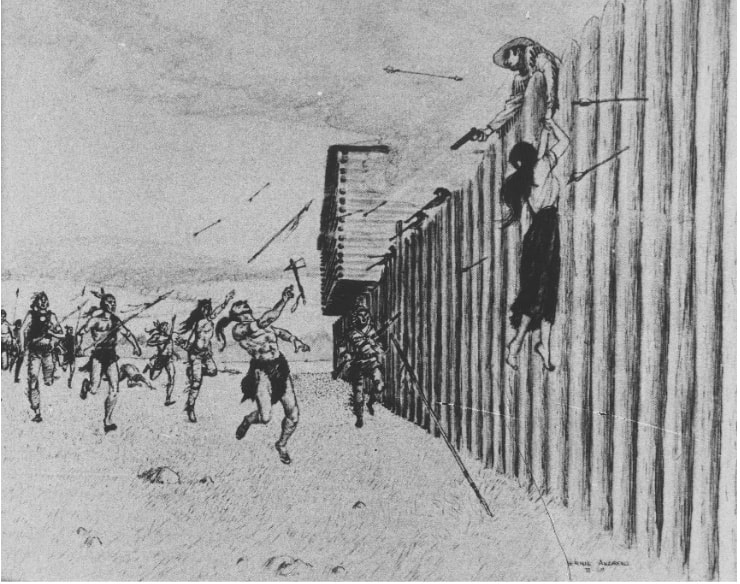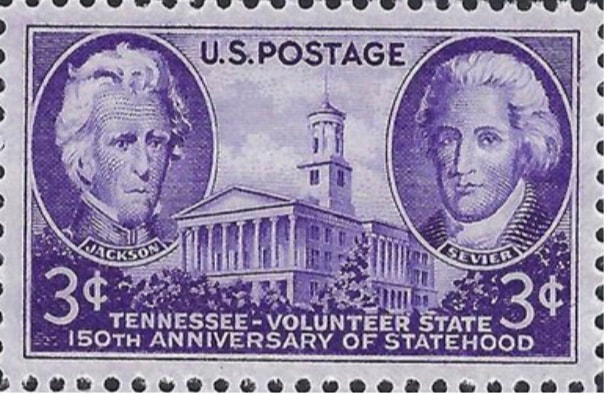- Home
- About
-
Chapters
- Regions of TNSSAR
- Andrew Jackson Chapter
- Christopher Strong Chapter
- Col. Anthony Bledsoe Chapter
- Col. Benjamin Cleveland Chapter >
- Col. Hugh Brown Chapter
- Cumberland Gap Chapter
- Forked Deer Chapter
- Governor Archibald Roane Chapter
- Hiwassee Chapter
- Isaac Shelby Chapter
- Jackson Purchase Chapter
- James Madison Chapter
- John Sevier Chapter >
- Joseph Greer Chapter
- Kings Mountain Chapter
- Lt. Andrew Crockett Chapter
- Lt. William P. Quarles Chapter
- Maj. David Wilson Chapter
- State of Franklin Chapter
- Stephen Holston Chapter
- Stones River Chapter >
- Thomas Kilgore Chapter
- Valentine Sevier Chapter
- Watauga Chapter
- Education Programs
- Color Guard
- Events
- Community Outreach
- Graves and Monuments
- For Members
- TNSSAR Store
- Ladies Auxiliary
Joseph Greer "Kings Mountain Messenger"
Early Life and Frontier Beginnings
Joseph Greer was born in Philadelphia in 1754 to Andrew and Ruth Kincade Greer, Irish immigrants who had recently settled in the American colonies. In the years following his birth, the family move to the frontier settlement of Staunton, Virginia. It was there that Joseph honed the essential skills of survival, self-reliance, and adaptability required to thrive in the wilderness. He became fluent in Native American languages and customs, which later proved invaluable in navigating the treacherous frontier.
By the 1780s, Greer was living in the Watauga Valley, a frontier community in what is now East Tennessee. The Watauga settlement was known for its independent spirit and played a crucial role in early Revolutionary efforts, including the defense of Fort Watauga during the Cherokee siege in 1776. Greer’s association with this community cemented his reputation as a skilled frontiersman and patriot.
The Battle of Kings Mountain
The Battle of Kings Mountain, fought on October 7, 1780, was a pivotal moment in the Revolutionary War. Patriot militia forces, composed largely of Overmountain Men from the Appalachian frontier, decisively defeated British Loyalist troops under Major Patrick Ferguson. The victory was a turning point in the Southern campaign, boosting morale and disrupting British efforts to recruit Loyalist support (WILLIAMS, 2021)
Joseph Greer participated in this battle, demonstrating his valor alongside fellow frontiersmen. Recognizing the significance of the victory, Colonel John Sevier, a trusted leader of the Overmountain Men, selected Greer to carry the news of their triumph to the Continental Congress. This task required not only physical endurance but also the resourcefulness and fortitude to navigate hostile terrain (STONE, 1916) .
The Legendary Journey to Philadelphia
Greer’s journey to Philadelphia, covering over 600 miles through rugged wilderness and perilous conditions, has become the stuff of legend. Armed with a musket, a brass compass, and a few essential supplies, he traversed the Southeast, avoiding British patrols and hostile Native American forces. One particularly dramatic account suggests that Greer’s horse was shot out from under him, forcing him to hide in a hollow log to evade capture.
|
While family lore and oral tradition have embellished aspects of this journey, historical evidence supports the fact that Greer arrived in Philadelphia on November 7, 1780, just 30 days after the battle. His timely delivery of the news electrified Congress, which had feared a defeat at Kings Mountain. Greer’s imposing stature—standing over six and a half feet tall and dressed in buckskins—also left a lasting impression. Some members of Congress reportedly remarked, “No wonder the Americans can win if this man is a sample of their soldiers” (HAMMETT, 2023).
Historical Context and Challenges |
|
Although myths surrounding Greer’s journeyoften depict him braving snowstorms, historical weather records suggest otherwise. The winter of 1779–1780 was indeed harsh, but Greer’s journey took place in October, well before the onset of snow in the region. However, rain and cold temperatures would have posed significant challenges, underscoring his resilience and expertise as a frontiersman.
Greer’s route likely followed the network of trails and paths established by Native Americans and later adapted by European settlers. The Great Valley Road, a major colonial thoroughfare, would have provided a relatively safe and direct path northward. This route allowed Greer to avoid areas of British control while accessing established settlements for supplies and rest. |
The King's Mountain Messenger
In Tennessee's wild realm, a stalwart soul, |
The lack of a personal account from Joseph Greer has lefthistorians to piece together his story from oral traditions, family records, and secondary sources. While the dramatic tales of his journey captivate imaginations, the true measure of his achievement lies in his ability to navigate a dangerous and unpredictable landscape with skill and determination. Extensive research into documentation in library archives fails to specifically mention a simple messenger delivering a message to Congress. Much of what is known about his feat of traveling to Philadelphia is from family lore, and deductive possibilities and reasoning of the legend being true. Nevertheless, it is known that his father was a personal friend of Colonel John Sevier, and it could be easily thought that Joseph was selected for this important task because of his skills as a frontiersman and him being known to Sevier. (Finding Aid for Joseph Greer Family Papers,, 1968) Some articles and book references mention his youth as being a factor. As he was born in 1754, by 1780 he would have been in the prime of youth but hardly a youngster. It can also be safely assumed that he was present at Fort Watauga and fought during the siege, discussed later.
Greer was born in Philadelphia in 1754, but his family soon moved to the frontier settlement of Staunton, Virginia. There, he learned the skills of survival and self-reliance necessary to thrive in the wilderness. He also became an expert in Indian languages and customs.
Joseph Greer’s Historic Journey: Fact, Legend, and Pathways
Pathways of the Southeast: Navigating the Wilderness
Greer’s journey cannot be fully understood without considering the intricate network of trails and paths that defined the Southeast in the 18th century. These routes, initially established by Native American tribes and later adapted by European settlers, played a crucial role in communication, trade, and migration.
|
The Great Valley Road, also known as the "Great Wagon Road," "Warriors’ Path," or "Trading Path," was among the most significant colonial routes. Stretching 735 miles from Philadelphia, Pennsylvania, to Augusta, Georgia, it traversed the
Shenandoah Valley of Virginia and forked into paths leading to the Tennessee Valley and the Piedmont region of North Carolina. This road, along with other trails like the Catawba Trail, formed the backbone of frontier movement and commerce. Tracing Greer's Likely Route While there is no definitive record of the exact path Greer took, historical context provides clues. Kings Mountain, located near the |
A Legacy of Resilience and Resourcefulness
Joseph Greer’s journey, though steeped in myth, remains a powerful symbol of resilience and resourcefulness. His ability to traverse hostile terrain and deliver vital news underscores the critical role played by individuals like him in shaping the course of the Revolutionary War. By examining both the historical evidence and the legends, we gain a richer understanding of his contributions and the broader significance of the trails and pathways that connected early America.
|
Through his journey, Greer not only carried a message of victory but also exemplified the enduring spirit of the frontiersman—a legacy that continues to inspire and captivate generations. The members of Congress were stunned and disbelieving when they heard Greer's news. They had been expecting a defeat at Kings Mountain, and Greer's arrival with news of victory was a welcome surprise. Greer's tall and imposing figure also made an impression on the members of Congress. He was over six feet tall, and he was dressed in buckskins and a coonskin cap. Many people in Philadelphia commented on his unusual size and appearance, and some said, "No wonder the Americans can win if this man is a sample of their soldiers." (HAMMETT, 2023) (DEWITT, 1916) (ALDERMAN, 1986)
|
dangers to deliver the news of victory to the Continental Congress. His message helped to boost morale and strengthen the
American resolve to fight on.
Later Life
Greer's legacy is one of patriotism and service. He was a true American hero, and his story is still told today. Because he served during the American Revolution, Joseph Greer received several land grants within Tennessee. One such land grant from the State of North Carolina dated December 17, 1794, gave Greer 2,566 acres of land along the east fork of Cane Creek. This would later be found in Lincoln County, Tennessee. At the earliest, Joseph Greer settled along Cane Creek about 1804.
There, Greer, along with his wife, Mary Ann, had eleven children. In 1831, Joseph Greer passed away.
An interesting spot in Middle Tennessee, because of its association with the pioneer history of the state, is the old Greer homestead on Cane Creek in what is now Lincoln County near the small town of Petersburg Tennessee.
The house stood amid a fertile farming section which is a part of the original grant of 2,600 acres received by Joseph Greer for service in the Revolutionary War. Joseph was the son of Andrew and Ruth Kincade Greer, who came to this country from Ireland in the year 1750. Andrew Greer, being so much below the average height, was dubbed "Wee Andy" and "Wee White-Headed Andy," so Joseph, who was of unusual height and strength, must have inherited his splendid physique from some remote ancestor of Scotch or Irish blood.
Beginning in the 1790s, Greer ran a store in Knoxville (which at the time was the capital of Tennessee) and served as a clerk on the Court of Equity from 1799 to 1801. He often corresponded with George Wilson, publisher of the Knoxville Gazette.
In 1789, Greer's service to his country was recognized with a land grant, marking the beginning of his journey westward (KEEFER, 2024) . However, it was not until 1804 that Greer made the momentous decision to sell his business in Knoxville, Tennessee, and embark on the arduous journey to claim his land grant obtained for his service in the Revolution and to purchase several thousand acres of land in the Cane Creek Valley in the vicinity of what is now the town of Petersburg
in Lincoln County.
Amidst the turbulent political and economic landscape of 1804, Joseph Greer made a pivotal decision that would shape the course of his future. In one of his letters to friend George Wilson, the founder of the Knoxville newspaper, he writes, “As to Knoxville parties get warmer, society gets worse, money gets scarcer, times harder… (Inventory, 2024) .” The political and economic climate preceding 1804 played a significant role in Greer's decision. The financial panic of 1791, orchestrated by Treasury Secretary Alexander Hamilton, had rattled the young nation, and underscored the fragility of its economic system. Despite the promise of prosperity, the road to success was fraught with uncertainty and risk. In the wake of the Revolutionary War, Congress revised the national land policy, making it easier for settlers to buy land in smaller parcels on credit. With the promise of abundant natural resources and cheap land, the frontier beckoned to those
seeking a fresh start and new opportunities. However, the economic landscape was not without its challenges.
At this threshold of a new era of expansion and growth, with territories like Tennessee still largely unsettled, land grants were a means of incentivizing veterans to pioneer and set up communities in these untamed lands. For Greer, this grant held the promise of a brighter future, a chance to build a home, and carve out a new life in the wilderness (COLIN, 1998) .
By 1804, Greer had sold his business in Knoxville and moved to his farm in the Cane Creek Valley. When the time came for Joseph Greer to take possession of his government land, he traveled down into Middle Tennessee and staked off a claim in what is now Lincoln County. Here he built his first home in 1804, and the rough house with its great stone chimneys (at that time). It is unknown exactly how long or who helped Joseph Greer build the dogtrot house. What is known is the house
was not big enough for his growing family.
In 1810 Greer built a larger and better house with five rooms. Joseph Greer's next house was built about a mile east of where the original dogtrot was found. It was closer to the Cane Creek and was described as a large frame house. It was in this house he and his good wife raised their eleven children, five girls, and six boys. This house, although newer, did not last as long as the original Joseph Greer Dogtrot house, as a later owner of the land parcel, Fred Pickering, tore the house
down and built the modern frame house that is there now.
The Greer land where the house was is now owned by the Gill Family who were raised on the farm. Warren Gill stated that, “The Greer Cabin did not have anybody living in it after Jake Edmiston (a tenant), but Daddy kept in fairly good shape until he couldn't keep it up anymore. So, it did not become "a ruin in a field" until around the 1980's or 90's.
Building a house in those days was no easy task, for all the work was done by hand, and it took the best carpenter in that section one entire year to complete the dwelling. For Greer and countless other pioneers, the allure of the frontier outweighed the challenges that lay ahead. Armed with determination and a pioneering spirit, Greer set out to claim his land and build a home for himself and his family. As Greer joined his neighbors in the age-old tradition of log raising, he became a part of the rich fabric of American history. Together, they forged communities out of the wilderness, laying the foundation for the growth and prosperity of a young nation.
|
In the end, Greer's decision to seek his fortune on the frontier was evidence of the resilience of the human spirit and the enduring promise of the American Dream. It was a journey fueled by courage, determination, and the unwavering belief in the possibility of a better tomorrow. As Greer raised his log house on the fertile soil of middle Tennessee, he left behind a legacy that would endure for generations to come.
Artifacts of Time Many odd and interesting relics of the "King's Mountain Messenger" are preserved at the Tennessee State Museum (Inventory, 2024) , among them his family Bible, in which are recorded the births, deaths and several old-fashioned garments which are now carefully preserved by descendants of Joseph Greer is a suit of homespun, consisting of coat, vest, and knee breeches, all remarkable for their unusual size. This suit was made by Mrs. Greer's |
In his will, Greer states that all his property is to be evenly divided amongst his children and gives his widow full designation thereof. The house found along Cane Creek stayed within the Greer family until 1943 when the property was bought by W.W. Gill, Sr. The Greer family cemetery is found near Petersburg, Tennessee, a short walk off of Three Hundred Dollar Road, and is the final resting place of Joseph Greer. In addition to Joseph’s grave, there is a marker at the site detailing Greer’s service in the Revolutionary War (MASTERS, 2024). Before his death, Joseph Greer set apart a plot of
ground for a family burial place, and on this spot, a short distance from his first rude house home, the "Kings Mountain Messenger" found his last resting place. The quaint tomb, built entirely of stone, bears the following inscription: “Here lyeth the body of Joseph Greer. He was, while living, an example of every virtue, distinguished for his benevolence and humanity. He died on the 23rd day of Feb. 1831, in the 77th year of his age, lamented by all who knew him." (STONE, 1916) .
|
The Kings Mountain Messenger
Chapter, D. A. R., of Fayetteville, Tenn., placed a handsome bronze tablet on this tomb in memory of Greer's distinguished service to his country, and Uncle Tom was the guest of honor at the unveiling ceremony. The bronze plaque was later moved to the Lincoln County Courthouse lawn. (Tullahoma, 2016) Andrew Greer – Joe’s Dad To properly place Joseph Greer into the early American experience, it is |
The historical interest that attaches to the first settlers of Tennessee, especially those on the Watauga, affords sufficient ground for putting on record in the Tennessee Historical Magazine something about Andrew Greer. The present time is opportune since Andrew Greer was the father of Joseph Greer, the subject of an interesting sketch in the March (1916) number of this journal.
Ramsey says in the Annals of Tennessee that "Andrew Greer was an Indian trader, and at a very early period, perhaps 1766, came with Julius Dugger to the West"; and that "Andrew Greer was one of the first if not the very first settler of Watauga." This statement as to the time of his coming west is corroborated by a record in the register's office, Charlottesville, Virginia, showing that Andrew Greer, September 11, 1776, sold his land in Albemarle County. This land was conveyed to Jeremiah Warder and Richard Parker, merchants of Philadelphia, Pa. According to Rev. Edgar Woods, this sale was made, in the liquidation of his debts as a merchant in that vicinity. (Legal Papers of Andrew Jackson, by Jackson, Andrew, 1767-1845,, 2022) (FROST J. L.)
Andrew Greer was the son of Alexander Greer of Gaughwaugher [sic] Ireland (probably Garvagh, Londonderry County). The tradition is that he came to America with two brothers and settled in the vicinity of Philadelphia. Leaving his brothers in Pennsylvania, he came to Virginia and lived for a time in Staunton, Augusta County, Virginia. Certain it is that he was a resident of Albemarle County in 1758 as he was then a sergeant in an "Albemarle company of militia lately in active service for the defense and protection of the frontier against the Indians." In the year 1834 or 1835 Michael Woods
came from Lancaster County, Pennsylvania, with several families into what is now Albemarle County, Virginia. The Kincaid or Kinkead family was one of these. There were three brothers, David, Joseph, and James. They settled in the western part of the county, on Medium's River. Andrew Greer, about the year 1751, married Ruth, daughter of Joseph Kincaid. Their children were Alexander, born in 1752, Joseph, born in 1754; Andrew, born in 1756, and Ruth, born in 1768.
"Watauga Old Fields," says Ramsey, "occupied the site of the present Elizabethton, in Carter County. Tradition says it was once an ancient Indian village, of which, when Mr. Andrew Greer, an early hunter and explorer, first settled it, no trace remained but the cleared land." Julius Dugger, who Figure 13 - Family plot and sign at Joseph Greer grave site.
came to the West with Greer, settled at a place afterward known as Bugger's Bridge, fourteen miles up the Watauga from Elizabethton. "They are believed," says Ramsey, "to be the first white men that settled south of what was afterward ascertained to be the Virginia line. After them came the Robertsons, John Carter, Michael Hyder, the Seviers, Dunjains, McNabbs, Matthew Talbot, the Hortons, McLinns, and Simeon Bundy. Soon after the arrival on the Watauga of the emigrants above named, came the Beans, the Cobbs, and the Webbs, and, later, the Tiptons and the Taylors." (FOOTE, 1846)
It is probable that Andrew Greer did not bring his family to Watauga at this time, but built a hunting lodge as headquarters, traded in furs with the Indians, and made periodical trips to the home place in Virginia. Some others began to come from that vicinity to the settlements on the Holston and Watauga, some of them influenced by his account of the new country. Among those who came at an early date were Valentine Sevier, from Augusta County, who stopped for a season on the Holston, then settled on the Watauga a mile or two below the site of Elizabethton, and Matthew Talbot, of Bedford County, who settled below Sycamore Shoals on or near the site of the Watauga fort. (DEWITT)
Ruth Kincaid, the wife of Andrew Greer, died about 1770, it is supposed. Her father, Joseph Kincaid, died in 1774. Then in 1775, Joseph Greer joined his father on the Watauga. That the other members of the family went with him or had gone there previously is inferred from the fact that the names of Andrew, Alexander, Joseph, and Andrew Greer, Jr., all appear among the signatures to the "petition and remonstrance" of 1775 or 1776, in which the inhabitants of the Washington district ask, among. other things, to be annexed to North Carolina.
Ramsey gives the following account of what he says was the commencement of Cherokee hostility in 1775: "Andrew Greer, being in the Cherokee towns, suspected of the conduct of Walker and another trader that some mischief was intended against him. He returned with his furs but left the main trading path and came up the Nolichucky Trace. Boyd and Doggett, who had been sent out by Virginia, traveling on the path thwarted left, were met by the Indians near a creek. The creek is in Sevier County and has ever since been known as Boyd's Creek. A watch and other articles were found in the creek afterward. The watch had Boyd's name engraved on the case. He was a Scotchman."
|
The next year the Cherokees attacked an attack upon the settlements. One division, led by Dragging Canoe, attacking the Holston settlement, was met, and defeated at the Island Flats near Long Island of the South Fork of the Holston. The other division, under the command of Old Abraham, invested and attacked the fort at Watauga. "Captain James Robertson commanded the forces at Watauga, amounting in all to but forty men. Lieutenant John Sevier and Andrew Greer were also present." The families of the settlers had been brought within the enclosure for protection. Mrs. Bean was captured by the Indians, and Catherine Sherrill, who became the wife of John Sevier, is said to have
|
The illustration is from a 1970 book entitled The Overmountain Men, by Pat Alderman. (ALDERMAN, 1986) It depicts one of the most dramatic incidents in early Tennessee history. According to contemporary accounts, several women had left Fort Watauga (in the Sycamore Shoals area of Northeast Tennessee) in the early morning of July 21, 1776, to milk the settlement's cows. women discovered a force of Cherokee warriors approaching the fort in a surprise attack. Their cries
awakened the men inside the fort in time for them to bar the fort's gates, man the palisade, and repulse the attack. Cut off from the entrance to the fort by advancing warriors, young Catherine "Bonnie Kate" Sherrill -- who was described as tall and athletic -- ran to another side of the fort and tried to climb the wall. The settler atop the palisade was John Sevier, who reached down to grasp Catherine's hand and pull her to safety. The two were married four years later. Sevier went on to
serve six terms as Governor of Tennessee and two terms in the United States House of Representatives. He is acknowledged as one of the "fathers" of Tennessee. The illustration itself reveals a good deal about the way white Tennesseans of the mid-20th century perceived the history of early white settlement. It depicts the attacking Cherokee, armed primarily with lances and bows, throwing themselves against the well-engineered walls of the settler fortress. This imagery draws
heavily on the Western movies and television programs of the period. In reality, the Cherokee warriors would have been armed primarily with flintlock guns supplied by the British and similar to those wielded by the white defenders. After the failure of the first attack, the Cherokee settled into a two-week siege intended to force the surrender of the white garrison, a strategy that had succeeded against a much larger white garrison at Fort Loudon some fifteen years before. The defeat and retreat of another Cherokee force at the Battle of Island Flats on July 20 influenced the Cherokee to break off the siege and retreat before more white militia forces arrived.
In the early days of Tennessee, particularly in 1772, the white settlements south of the Holston River lacked any formal government, although they were recognized as part of North Carolina. In response, the settlers organized themselves and set up the Watauga Association, a written agreement for the management of general affairs. Thirteen citizens were chosen as Commissioners in a convention, including notable figures like John Sevier and Charles Robertson.
By 1775, the Wataugans purchased their lands from the Cherokee Nation, solidifying their claim. In August 1776, they petitioned North Carolina for recognition of their government, now termed "Washington District." The petition, believed to have been signed in 1776, was formally received on August 22, 1776. North Carolina accepted the Washington District government, allowing it to send representatives to the Provincial Congress in Halifax in November 1776, marking a significant step towards formal acknowledgment. Andrew Greer and his son Joseph Greer are signatories of the petition.
|
In the following year, the North Carolina General Assembly, in its November 1777 session, approved the formation of Washington County, defining its boundaries to encompass most of present-day Tennessee. This delineation marked a crucial moment in the establishment of the region's governance, laying the groundwork for the next development of the
state. The District of Washington, which at that time embraced all the territory now in the State of Tennessee, was annexed by the Legislature to North Carolina in 1776. |
kinds of currency and coins in circulation to detect and prevent frauds and impositions. He was a collector of the public and county taxes for the year 1783. When Carter County was set up by the Legislature in 1796, he was appointed one of the commissioners to select the site for the courthouse and to erect county buildings. From that time until he died in 1806, he took an active part in the administration of public affairs in that county.
|
The Court of Pleas and Quarter Sessions for the district was set up by the Legislature in 1777, and twenty-five magistrates were appointed by the governor. Andrew Greer was one of these. He was present at the first meeting of the court on February 23, 1778, which was held at the house of Charles Robertson, one of the magistrates; and he served as a member of this court continuously, or so, until 1796. In 1780 he was appointed by the court as one of the judges to examine the various kinds of currency and coins in circulation to detect and prevent frauds and impositions.
|
|
Historical Note: The bitter feud between John Sevier and Andrew Jackson grew out of a dispute over military appointments both men competed over a position as major general of the Tennessee militia. The relationship between Sevier and Jackson deteriorated after Jackson accused Sevier of land fraud, asserting that Sevier conspired to destroy original records of land ownership, replacing them with forged claims. On October 1, 1803, the two men met on the steps of the Old Knox County Courthouse and traded heated words. Gov. Sevier brandished his sword, dared Jackson to draw arms, and then insulted Jackson's wife, Rachel, resulting in a physical confrontation. Jackson lunged at Sevier with his cane, then friends of both parties drew pistols, and shots rang out as a bullet grazed at least one bystander. After allies of both men separated the two, a war of words between the governor and the judge quickly escalated in an exchange of letters. In their correspondence, Jackson requested an 'interview' with Sevier--a commonly understood term for a duel. Dueling, however, was prohibited within the borders of Tennessee, so Sevier offered to meet Jackson at any time and place, not within the State of Tennessee. Thereafter the two men argued over the timing and location to settle their dispute. Eventually, Jackson met Sevier near present-day Kingston, Tennessee, where a failed attempt at a duel took place. Loyalists to both men provided conflicting accounts and details surrounding the chaotic events of that day in affidavits signed by witnesses and in published newspaper Figure 16 - United States Stamp from 1946, Tennessee Capitol Andrew Jackson John Sevier – Commemorating Tennessee’s 150th Year of Statehood, not the famous altercation. accounts of the incident. Tempers cooled, but the animosity between Sevier and Jackson remained until Sevier died in 1815. (Belt, Gordon T., and Traci Nichols-Belt. John Sevier: Tennessee's First Hero. Charleston: The History Press, 2014)
|
good judgment and taste in selecting a location fronting the Watauga River, with Holston Mountain as a background, in the upper end of what Governor Robert L. Taylor named the Happy Valley. He possessed at one time all or all the lands along the river on the north side, extending up the river three or four miles from the Tumbling Shoals at Elizabethton. Part of the property, near Elizabethton, which he sold in 1797, became the Stover place, where President Andrew Johnson died, at the home of his daughter, Mrs. Stover. One thousand acres which he reserved as a homestead was sold by his heirs to John Nave. Mrs. Sharp, a granddaughter of John Nave, who lives on the place, pointed out to the writer the site of the residence of Andrew Greer in an old apple orchard near the bank of the river. His grave could not be found; but it is supposed that he was buried at the upper end of the place, near the mouth of Stoney Creek in an old cemetery that was obliterated by the high waters of the Watauga River in 1910.
- ALDERMAN, P. (1986). The Overmountain Men. Johnson City, TN, USA: Overmountain Press. Retrieved 2022, from https://archive.org/details/overmountainmenb0000alde
- DEWITT, J. H. (1916). “Kings Mountain Messenger:” A Tradition of the Greer Family. (J. H.-1. DEWITT, W. A.-1. Provine, S. G.-1. Sioussat, & S. G.-1. Sioussat, Eds.) Tennessee Historical Society, 2. Retrieved 2022, from https://archive.org/details/tennessee-historical-magazine-vol-2-1916/page/40/mode/2up?q=%22Joseph+Greer%22, https://archive.org/details/tennesseehistori02dewi
- FROST, J. (1816). Pictorial Life of Andrew Jackson, Embellished with Numerous Engravings, from Designs by William Croome. Act of Congress and the Clerk of the District Court. Retrieved from https://www.google.com/books/edition/Pictorial_life_of_Andrew_Jackson_Embelli/_rtcAAAAcAAJ?hl=en
- FROST, J. L. (n.d.). FROST, John, LLD., Pictorial Life of Andrew Jackson, Embellished with Numerous Engravings, from Designs by William Croome. Entered according to the Act of Congress, in the year 1816, In the office of the Clerk of the District Court of the United States, in and for the Eastern District of Pennsylvania. Retrieved from https://www.google.com/books/edition/Pictorial_life_of_Andrew_Jackson_Embelli/_rtcAAAAcAAJ?hl=en
- FOSTER, S. & Putnam, A. W. (1896). The Battle of Kings Mountain. The American Historical Magazine, 1(1), 22–47. Retrieved from http://www.jstor.org/stable/43700485
- HAMMETT, C. (2023). The Battle of Kings Mountain. Retrieved June 15, 2023, from TNgenweb.org: https://www.tngenweb.org/revwar/kingsmountain.html
- Historical Statements Concerning the Battle Of Kings Mountain and the Battle Of The Cowpens. (1928). Retrieved from United States Government Printing Office, Washington DC,: https://ia800308.us.archive.org/12/items/historicalstatem00army/historicalstatem00army.pdf
- KEEFER, V. L. (2024, March). Tennessee Records Repository - TNGenWeb. Retrieved from Tennessee Records Repository - North Carolina Land Grants in TN 1778-1791: https://tngenweb.org/records/tn_wide/land/landgrants/nc_grants_western.html
- Tennessee Virtual Archive. (2024, April 24). Exhibit of Joseph Greer. Retrieved from Tennessee State Museum (War Memorial Building): https://cdm15138.contentdm.oclc.org/digital/collection/p15138coll28/id/782/rec/1
- TNHistory. (2024). TN History for Kids. Retrieved 2024, from Kings Mountain SC: https://www.tnhistoryforkids.org/history/out-of-state/kings-mountain/
- Tullahoma, T. N. (2016, June 16). Gravesite of ‘Kings Mountain Messenger’ Restored. The News. Retrieved from https://www.tullahomanews.com/news/local/gravesite-of-kings-mountain-messenger-restored/article_b6c5b473-0b2c-5bd4-ac5c-6be3178d4b4c.htm
|
Questions? Contact Us.
info@tnssar.org
|
The Tennessee SAR is a proud member of
the SAR Southern District. Click the image to visit their site.
|
- Home
- About
-
Chapters
- Regions of TNSSAR
- Andrew Jackson Chapter
- Christopher Strong Chapter
- Col. Anthony Bledsoe Chapter
- Col. Benjamin Cleveland Chapter >
- Col. Hugh Brown Chapter
- Cumberland Gap Chapter
- Forked Deer Chapter
- Governor Archibald Roane Chapter
- Hiwassee Chapter
- Isaac Shelby Chapter
- Jackson Purchase Chapter
- James Madison Chapter
- John Sevier Chapter >
- Joseph Greer Chapter
- Kings Mountain Chapter
- Lt. Andrew Crockett Chapter
- Lt. William P. Quarles Chapter
- Maj. David Wilson Chapter
- State of Franklin Chapter
- Stephen Holston Chapter
- Stones River Chapter >
- Thomas Kilgore Chapter
- Valentine Sevier Chapter
- Watauga Chapter
- Education Programs
- Color Guard
- Events
- Community Outreach
- Graves and Monuments
- For Members
- TNSSAR Store
- Ladies Auxiliary


